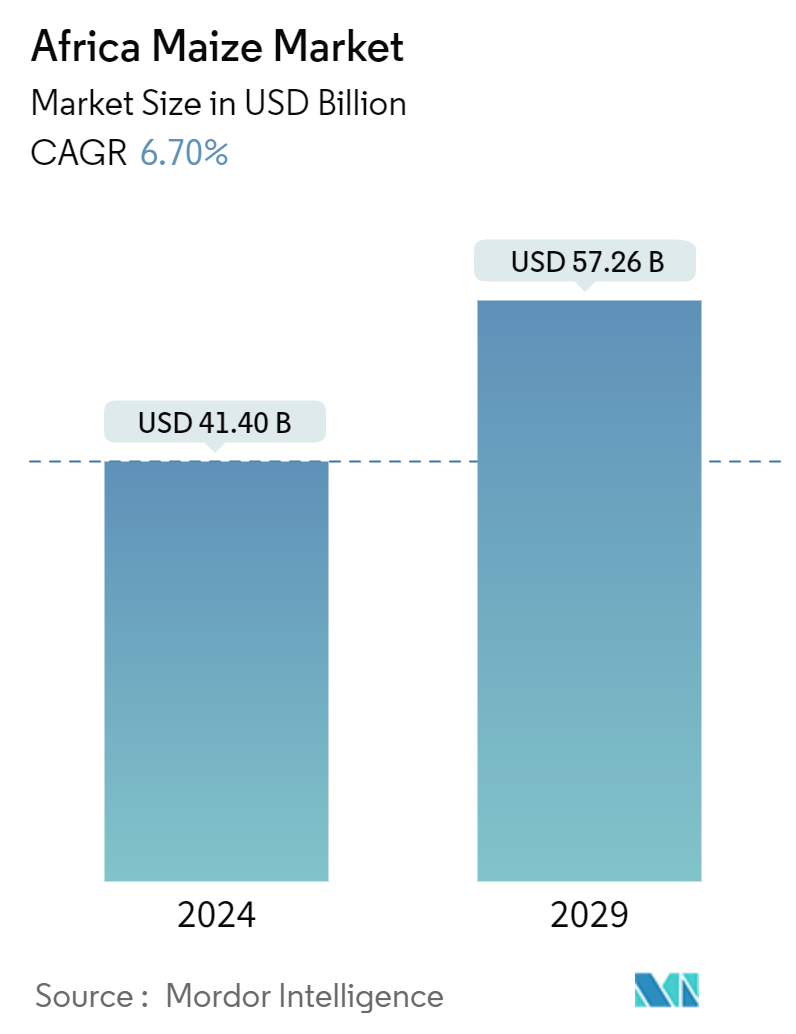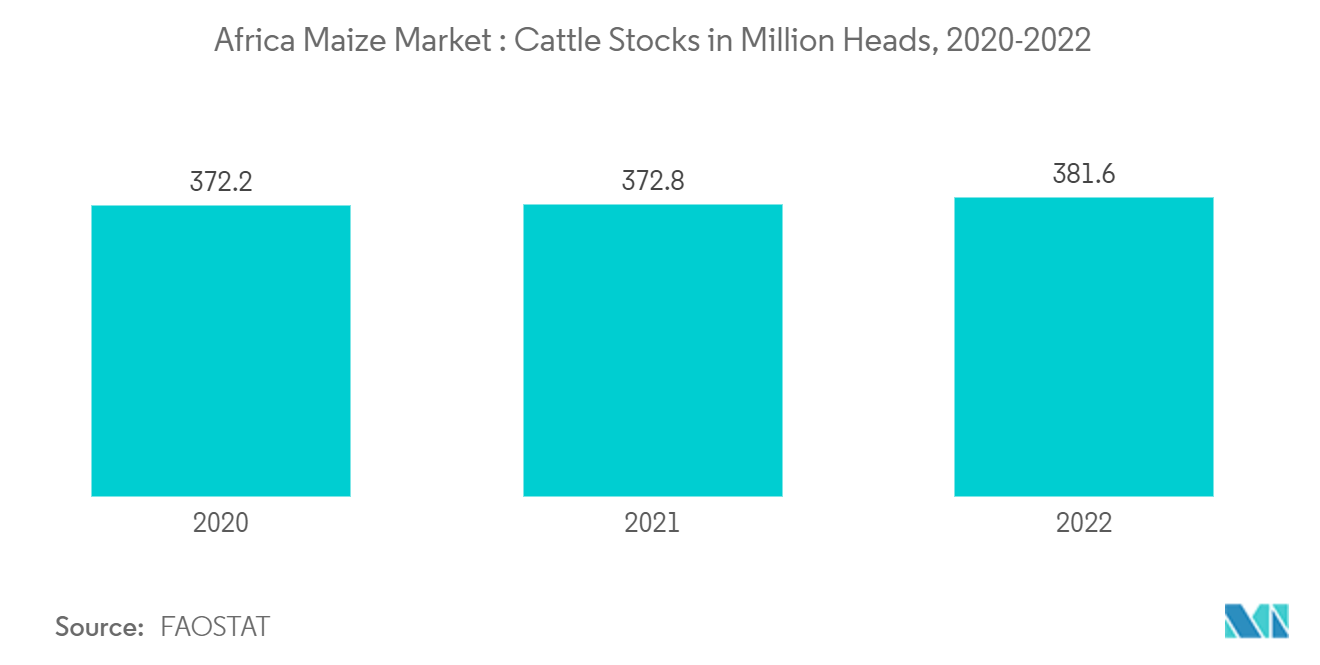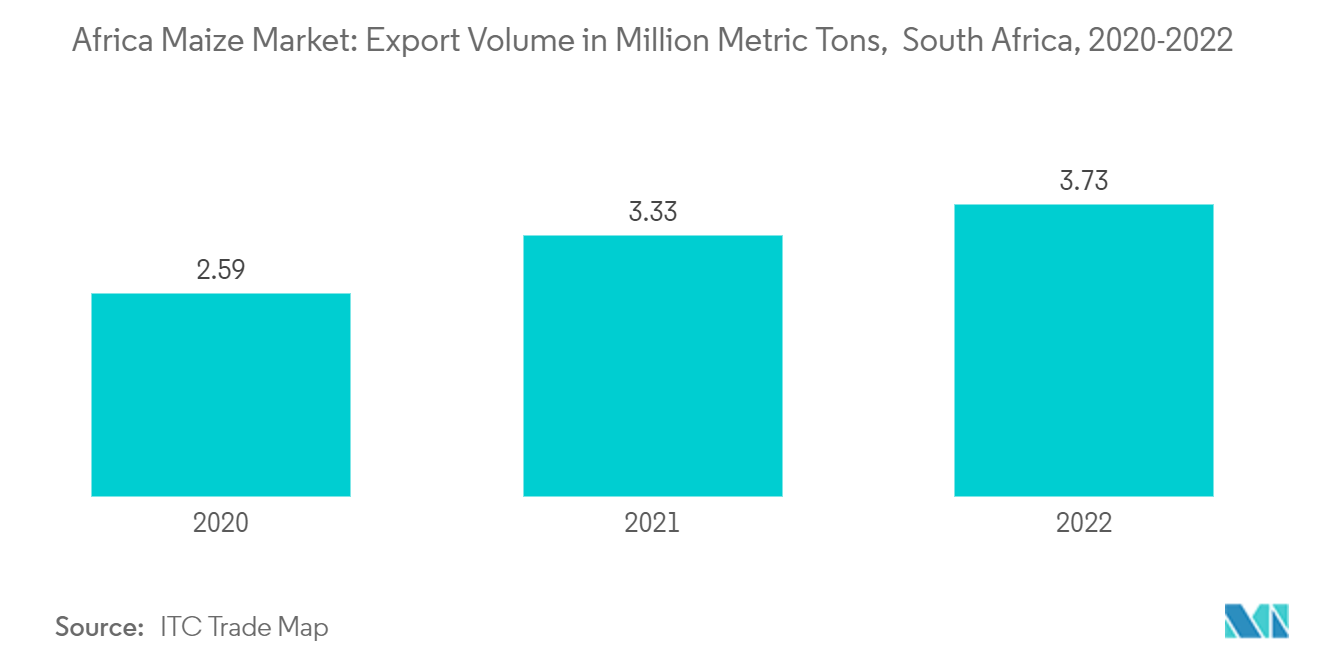Africa Maize Market Size

| Study Period | 2019 - 2029 |
| Base Year For Estimation | 2023 |
| Forecast Data Period | 2024 - 2029 |
| Market Size (2024) | USD 41.40 Billion |
| Market Size (2029) | USD 57.26 Billion |
| CAGR (2024 - 2029) | 6.70 % |
Major Players*Disclaimer: Major Players sorted in no particular order |
Africa Maize Market Analysis
The Africa Maize Market size is estimated at USD 41.40 billion in 2024, and is expected to reach USD 57.26 billion by 2029, growing at a CAGR of 6.70% during the forecast period (2024-2029).
Maize is considered to be the staple food for most parts of Sub-Saharan Africa. The popularity and production of maize are increasing significantly, with government aid and investments flooding the African agriculture sector. Maize is also considered a food security crop in different parts of Africa as it can be easily produced in different regions year-round according to weather conditions. It provides income for most households that depend on agriculture. The major driving factors for the increasing production are the increasing population pushing food scarcity to new highs and the increasing demand for maize from other sectors like animal feed.
Africa consumes 30% of the maize produced in the world, with Sub-Saharan Africa accounting for 21.0% of the consumption. Around 14 countries in Africa consume 85-95% of maize as their staple food and are more inclined to consume white maize, with a consumption share of around 90.0%. Thus, white maize has a premium price in the country. Most of the maize is produced in rain-fed areas. However, it is also grown in Africa's drought and famine-stricken regions.
According to the FAOSTAT, the total harvested area under maize in the region was around 42 million hectares in 2022. South Africa is the largest producer of maize in Africa, followed by Nigeria. According to the USDA reports, maize production in Africa increased by almost 8.2% in 2022 from the last 5 years, estimated to be 92.8 million metric tons. In 2021, South Africa contributed 1.34% of the global maize production, according to the USDA Foreign Agricultural Service survey.
The exports from Africa increased by 75.38% in value from 2019 to 2022 and reached USD 62.8 billion in 2022, according to the ITC trade data. Strategic trade agreements, climate-resilient crop varieties, supportive government policies, economic diversification, and technological advancements have also played crucial roles. These factors collectively boosted production and export capacity, making Africa a competitive player in the global maize market during the forecast period.
Africa Maize Market Trends
Application in the Animal Feed Industry is Boosting the Market
Due to nutritional values, ease of production, and availability, maize is becoming an important alternative to the animal feed industry. Cereals are the most widely used ingredient in feeds across the world, including Africa. Maize is the most common cereal ingredient used to manufacture feed in the region. The increasing cattle population is leading to the demand for animal feed production. According to the Alltech Global Feed Survey, in 2021, 44.2 million metric tons of feed was produced in Africa alone, a 2.4% growth from the previous year. Broiler feed production reached 11.7 million metric tons in 2021, a 1.1 % growth from the previous year, and aquaculture feed production also saw an increase in the same period, reaching 1.49 million metric tons.
As maize is the major ingredient in feed manufacturing, the demand for maize production is increasing. According to the FAO, total cattle stock increased by 6% in 2022 compared to 2019. Maize as a feed ingredient can increase egg production in poultry and meat mass in other animals. With low cost and easy availability, maize has become one of the best alternatives for producing animal feed with adequate nutrients. Yellow corn is one of the most widely used primary ingredients for animal feeds. In South Africa, around 65% of the maize produced is white, and the rest, 35%, is yellow maize used for animal feed. In the case of Uganda, 37% of the maize produced is used for animal feed.
Approximately 60% of the maize produced globally is used for animal feed, and the sudden increase in the consumption of poultry in Africa has increased the demand for maize as livestock feed. This, in turn, has stimulated the demand for maize as a feed ingredient in the region, and this is anticipated to drive the maize market during the forecast period.

South Africa is Expected to Dominate the Market
South Africa is the largest and most active producer of maize in Africa, and it has a relatively dry climate that contributes to a unique hardness and whiteness, which is of great importance to the milling industry. Hard maize ensures a higher-quality product and yield per ton, while whiteness is of importance to the consumer market. In South Africa, approximately 65.0% of the maize produced for human consumption is white, whereas the remaining 35.0% is yellow and used for animal feed.
On a local level, maize is the most widely grown field crop and the most important source of carbohydrates in South Africa. South Africa is currently the continent's leading maize producer, with the majority of output concentrated in the North West region, the Free State, the Mpumalanga Highveld, and the KwaZulu-Natal Midlands. White maize accounts for over half of the total output of human consumption. Regions such as Free State, Mpumalanga, and the North-West provinces accounted for 84.0% of the country's overall production of maize in 2021.
In 2021, 22% of the total maize produced in the country was exported to Japan. Botswana, Vietnam, Japan, Taiwan, China, South Korea, the Republic of Zimbabwe, Mozambique, Eswatini, and Tanzania are the primary importers of maize from South Africa. The changing food patterns and developments in maize processing can be attributed to the increasing demand for maize, which is likely to increase its exports.
Maize by-products have wide potential for various industries in the domestic market. According to Grain South Africa, maize by-products are currently being used in animal feed, the food industry, textile and paper, pharmaceuticals, and the alcohol industry in South Africa. As these allied markets grow, the demand for maize is expected to increase during the forecast period.

Africa Maize Market News
January 2024: The Federal Government of Nigeria approved the commercial release of genetically modified insect-resistant and drought-tolerant maize varieties, known as TELA maize.
October 2022: Kenya approved GMOs after a 10-year ban on the use of this technology, and this is expected to bring a major shift in the current crop production scenario in the country.
August 2022: The United States provided USD 120 million as part of its international efforts to support livelihoods and nutrition. A part of this fund was allotted to Africa to invest in good-quality seeds for wheat, rice, maize, etc., for the next four years.
Africa Maize Market Report - Table of Contents
1. INTRODUCTION
- 1.1 Study Assumptions and Market Definition
- 1.2 Scope of the Study
2. RESEARCH METHODOLOGY
3. EXECUTIVE SUMMARY
4. MARKET DYNAMICS
- 4.1 Market Overview
-
4.2 Market Drivers
- 4.2.1 Increasing Demand Due to Growing Population
- 4.2.2 Increasing Application in Animal Feed
- 4.2.3 Supportive Government Policies and Subsidies
-
4.3 Market Restraints
- 4.3.1 Pest and Disease Infestation
- 4.3.2 Inadequate Infrastructure Leading to Post-harvest Losses
- 4.4 Value Chain Analysis
5. MARKET SEGMENTATION
-
5.1 Geography (Production Analysis by Volume, Consumption Analysis by Volume and Value, Import Analysis by Volume and Value, Export Analysis by Volume and Value, and Price Trend Analysis)
- 5.1.1 South Africa
- 5.1.2 Ethiopia
- 5.1.3 Zambia
- 5.1.4 Nigeria
- 5.1.5 Malawi
6. MARKET OPPORTUNITIES AND FUTURE TRENDS
** Subject To AvailablityAfrica Maize Industry Segmentation
Maize is one of the cereal grains commonly known as corn and is a major cereal crop grown in the region. The African maize market provides the production (volume), consumption (value and volume), and trade in terms of import (value and volume), export (value and volume), and price trend analysis of maize in Africa. The market is segmented by geography (South Africa, Ethiopia, Zambia, Nigeria, and Malawi). The report offers market estimation and forecasts in value (USD) and volume (metric tons) for the above-mentioned segments.
| Geography (Production Analysis by Volume, Consumption Analysis by Volume and Value, Import Analysis by Volume and Value, Export Analysis by Volume and Value, and Price Trend Analysis) | South Africa |
| Ethiopia | |
| Zambia | |
| Nigeria | |
| Malawi |
Africa Maize Market Research FAQs
How big is the Africa Maize Market?
The Africa Maize Market size is expected to reach USD 41.40 billion in 2024 and grow at a CAGR of 6.70% to reach USD 57.26 billion by 2029.
What is the current Africa Maize Market size?
In 2024, the Africa Maize Market size is expected to reach USD 41.40 billion.
What years does this Africa Maize Market cover, and what was the market size in 2023?
In 2023, the Africa Maize Market size was estimated at USD 38.63 billion. The report covers the Africa Maize Market historical market size for years: 2019, 2020, 2021, 2022 and 2023. The report also forecasts the Africa Maize Market size for years: 2024, 2025, 2026, 2027, 2028 and 2029.
Africa Maize Industry Report
Statistics for the 2024 Africa Maize market share, size and revenue growth rate, created by Mordor Intelligence™ Industry Reports. Africa Maize analysis includes a market forecast outlook to 2029 and historical overview. Get a sample of this industry analysis as a free report PDF download.



